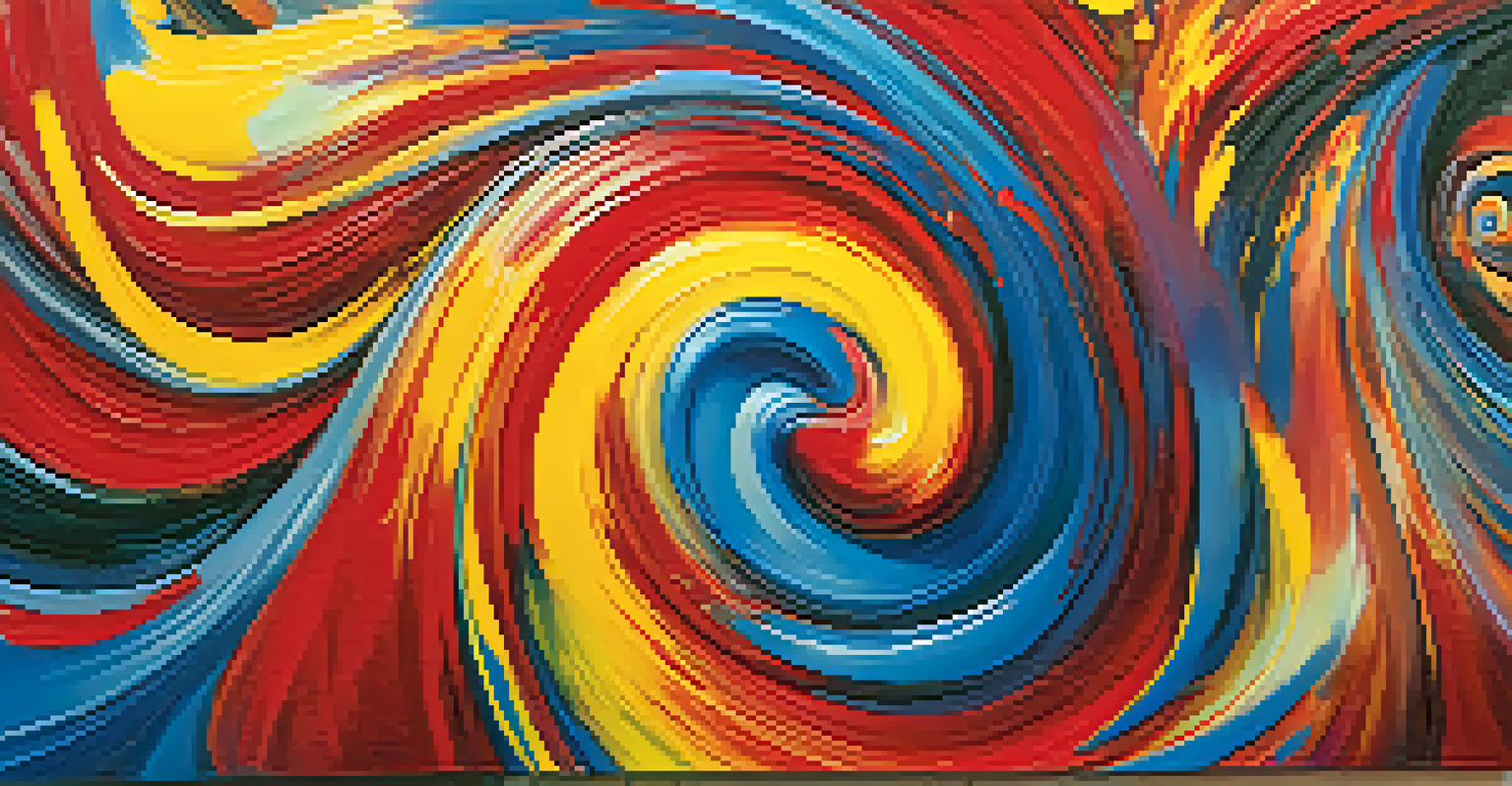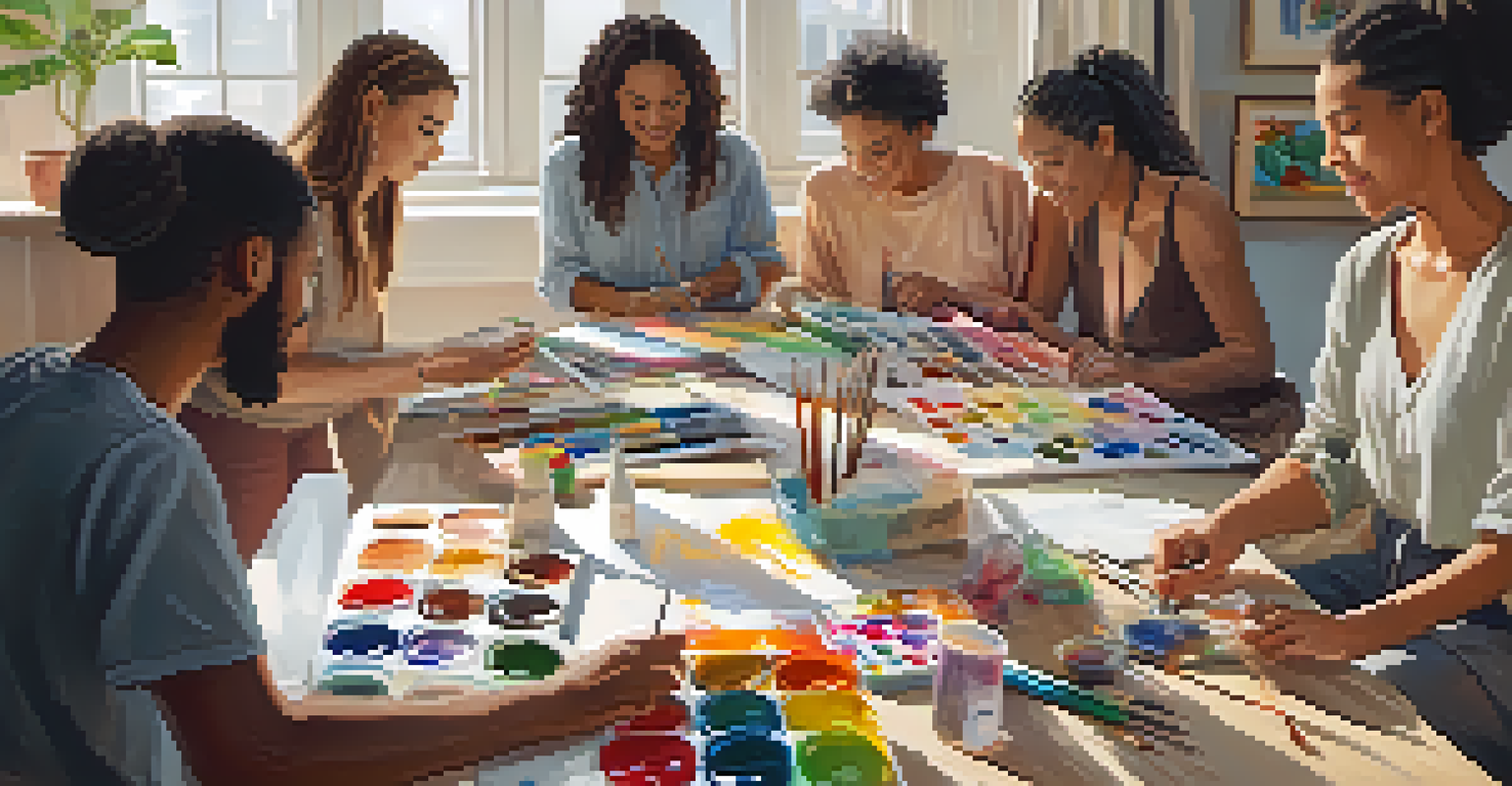The Influence of Art Movements on Emotional Perception Today

Understanding Art Movements and Their Historical Context
Art movements are often reflections of the cultural, political, and social climates of their time. For instance, the Impressionist movement emerged in the late 19th century, challenging traditional artistic techniques and perspectives. Artists like Monet and Renoir sought to capture fleeting moments and emotions, using light and color in innovative ways. This historical context is crucial to understanding how these movements continue to resonate with us today.
Color is the keyboard, the eyes are the harmonies, the soul is the piano with many strings.
By examining the backgrounds of these movements, we see how they correspond to emotional responses. The bold colors of Expressionism, for example, were used to convey intense feelings, often mirroring the turmoil of the early 20th century. Such emotional expressiveness allows viewers to connect on a personal level, engaging with artworks beyond their aesthetic value.
Today, we carry the legacies of these movements in our emotional perceptions. The way we interpret art is often shaped by the narratives that have evolved over time, making art a powerful tool for eliciting feelings and sparking discussions. This connection between past and present is what makes the study of art movements so compelling.
The Role of Color and Form in Emotional Expression
Color and form are fundamental elements in art that can significantly influence our emotional responses. For example, warm colors like red and orange often evoke feelings of passion and energy, while cooler tones such as blue and green can promote calmness and serenity. Artists throughout history have harnessed these associations to communicate their intended messages and feelings to viewers.

Consider the works of Van Gogh, whose swirling skies and vibrant colors convey deep emotions, reflecting his own struggles with mental health. His painting 'Starry Night' goes beyond mere representation; it invites viewers to feel a sense of wonder and turmoil simultaneously. This emotional layering is a testament to how color and form can shape our experience of art.
Art Reflects Cultural Context
Art movements are deeply intertwined with the cultural, political, and social climates of their time, influencing how emotions are expressed and perceived.
In contemporary art, these principles remain relevant. Artists continue to experiment with color and form to provoke specific emotional reactions, enhancing viewer engagement. By understanding these elements, we can appreciate the depth of emotional perception that art movements offer, fostering a richer connection to the artworks we encounter.
Modern Art Movements and Their Impact on Today’s Emotions
Modern art movements, such as Abstract Expressionism and Pop Art, have transformed how we perceive emotions in art. These movements challenged conventional ideas of beauty and representation, allowing artists to express personal and societal feelings in new ways. The spontaneity of Abstract Expressionism, for example, invites viewers to interpret emotions through the chaos of brush strokes and color interplay.
Art is not freedom from discipline, but disciplined freedom.
Take, for instance, the works of Jackson Pollock. His drip paintings are not just random splatters; they encapsulate a visceral energy and emotion that can resonate deeply with viewers. The act of creation becomes a release, allowing audiences to feel the artist’s emotional journey, which can mirror their own experiences.
In today’s art landscape, we see echoes of these movements as artists draw inspiration from their predecessors. The emotional authenticity that modern art champions continues to resonate, encouraging individuals to reflect on their own feelings and experiences. This connection is vital in a world that often feels disconnected, showcasing the enduring influence of art on our emotional lives.
Cultural Context and Emotional Resonance in Art
The cultural context surrounding an artwork significantly impacts its emotional resonance. In different parts of the world, symbols, colors, and themes can carry unique meanings, shaping how art is perceived and felt. For example, red may symbolize luck in some Eastern cultures, while in the West, it often represents love or danger.
This cultural diversity enriches our emotional understanding of art. When we engage with artworks from various backgrounds, we can experience a range of emotions that reflect the artist's cultural narrative. This interaction promotes empathy and a broader understanding of human experiences, allowing viewers to connect with emotions that may be unfamiliar yet profoundly impactful.
Color and Form Shape Emotions
The use of color and form in art plays a crucial role in evoking specific emotional responses, connecting viewers to the artist's intended message.
Thus, recognizing the cultural context of art movements helps us appreciate the layers of meaning embedded within artworks. It encourages us to explore beyond our immediate interpretations, fostering a more nuanced emotional engagement with art across different cultures and histories.
Art Therapy and Emotional Healing Through Artistic Expression
Art therapy has emerged as a powerful tool for emotional healing, leveraging the principles of art movements to foster self-expression and recovery. Through creating art, individuals can explore and articulate complex emotions that may be difficult to verbalize. This therapeutic approach draws on the emotional depth inherent in various art movements, offering a safe space for healing.
For instance, the chaos of Abstract Expressionism can be mirrored in the emotional turmoil of a person experiencing trauma. Engaging in similar creative processes allows individuals to confront their feelings, using color and form to express what words often cannot. This cathartic release can be incredibly liberating, promoting emotional well-being.
As we recognize the therapeutic benefits of art, we also see how contemporary artists incorporate these principles into their work. Many artists use their platforms to address mental health issues, creating dialogue and fostering community around emotional experiences. This intersection of art and healing highlights the enduring influence of art movements on our emotional perception today.
The Influence of Digital Art on Emotional Perception
In recent years, digital art has transformed how we create and perceive emotions in art. This medium allows for innovative experimentation with color, form, and interactivity, pushing the boundaries of traditional art movements. Digital artists can manipulate visuals in ways that evoke emotions dynamically, engaging viewers in an immersive experience.
For instance, virtual reality art installations provide an unparalleled emotional experience, allowing audiences to step into a world crafted by the artist. This level of engagement can amplify emotional responses, making viewers feel as though they are part of the artwork itself. The ability to navigate and interact with art in this way is a significant shift from traditional viewing experiences.
Digital Art Expands Emotional Reach
Emerging digital art forms are revolutionizing how we engage with emotions in art, creating immersive experiences that enhance viewer connection.
As digital art continues to evolve, it challenges our understanding of emotional perception in art. The accessibility of digital platforms also democratizes art, allowing more diverse voices to share their emotions and experiences. This shift not only enriches our emotional engagement with art but also reflects the changing landscape of how we perceive and interact with creative expression.
The Future of Art Movements and Emotional Connection
As we look to the future, the evolution of art movements will undoubtedly continue to shape our emotional perceptions. Emerging technologies, cultural shifts, and global conversations will influence how artists express themselves and how we respond emotionally. The blending of traditional and contemporary techniques will likely lead to new movements that challenge existing norms and expand our understanding of emotion in art.
Moreover, the ongoing dialogue around mental health and emotional well-being will further drive artists to create work that resonates deeply with audiences. As society becomes more open to discussing emotions, we may see a surge in art that reflects vulnerability and authenticity, encouraging viewers to connect with their own emotional experiences.

Ultimately, the future of art movements holds immense potential for deepening our emotional connections. By embracing the legacies of past movements while exploring new frontiers, artists can create powerful experiences that resonate across generations, reminding us of the profound impact art has on our emotional lives.